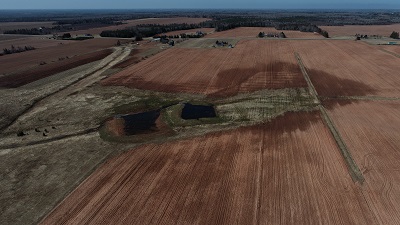
There’s a parcel of land next to a farm in Souris, Prince Edward Island (PEI) that’s just hopping! Hopping with new frog species, that is. Andrea McKenna was encouraged to learn that the Souris and Area Branch of the PEI Wildlife Federation counted three different frog species next to farm fields. Andrea is the Executive Director of the East Prince Agri-Environment Association, and she isn’t surprised to find this level of biodiversity next to this particular farm in Bear River. It’s the result of many months of planning, followed by the construction and restoration of wetlands on farmland like this and across PEI as part of Living Lab – Atlantic.
The Association has welcomed the participation of more than a dozen farmers and is the lead partner for Living Lab – Atlantic, a four-year collaborative initiative through Agriculture and Agri-Food Canada (AAFC). For the duration of the project, farmers, scientists and environmental organizations, will co-develop, test and share innovative practices that are tailored to local farms and address key agri-environmental issues. Launched in 2019, Living Lab – Atlantic activities are addressing key areas affecting farmers and lands on PEI, including soil health, water quality, crop productivity and biodiversity.
A project that benefits all Islanders
The development of new wetlands isn’t just benefitting farmers. Human activity has caused wetlands in Canada to disappear at an alarming rate. In an effort to reverse this trend, funding through AAFC has been ear-marked to develop wetlands on farmland that’s not suitable for crop production, but can still be valuable in providing benefits for the environment.
“Since 2019, we have constructed four wetlands around PEI, and plan to continue more work over the next two years,” says Andrea McKenna.
These wetlands naturally filter water from farm fields before it enters other watercourses, and provides natural habitats for diverse species such as plants, insects, amphibians, birds, waterfowl, like ducks, and other wildlife species. Wetlands even reduce greenhouse gas emissions to protect us from the effects of climate change.
According to Andrea, “wetlands have been incredible uses for non-farmable land that otherwise would have been left overgrown, and farmers are delighted to be contributing their land to improve the environment for all Islanders.”
A ripple effect
It’s not just new species that are flocking to these new wetlands. Several environment groups and conservationists are taking notice of this important work as part of Living Lab – Atlantic. Ducks Unlimited Canada, which also received funding from AAFC under the Living Lab – Atlantic project, have applauded the support of the East Prince Agri-Environment Association and its partners, including the Kensington North Watersheds Association and the Souris and Area Branch of the PEI Wildlife Federation. They are key to conserving these wetlands on PEI. Considering that 65 per cent of coastal wetlands have been altered in Atlantic Canada, these conservation partnerships are needed now more than ever.
“At Ducks Unlimited Canada, we partner with landowners, governments, and other conservation organizations to restore and protect wetlands and surrounding upland habitat. These partnerships result in a ripple effect, and lead to greater conservation success,” says Tom Duffy, Manager of Provincial Operations for Ducks Unlimited Canada Atlantic.
“This work positively impacts our landscape by improving water quality, sequestering carbon and providing habitat to a variety of wildlife species.”
Investigating other ways to improve water quality
While wetland construction continues, AAFC scientists are leading another Living Lab – Atlantic activity to investigate the use of constructed vegetated ditches to create buffer zones between farm fields and surface water sources like rivers and lakes. These several foot deep ditches are more commonly used in warmer southern temperatures and are an economical way for farmers to naturally filter water from farms before entering watercourses, similarly to wetlands, but on a smaller scale.
Over the next two growing seasons, scientists will be studying their effectiveness to improve water quality in cooler Maritime climates. Additionally, these kinds of ditches can also provide good habitat for beneficial plants and animals.
Celebrating conservation partnerships
There is more work to be done, but these partnerships through Living Lab – Atlantic are powerful drivers of change, and their efforts to restore the environment for future generations is not going unnoticed.
“Not that they needed any extra motivation, but knowing that our farmers are being recognized for their positive contribution to the environment provides that extra little bit of inspiration,” says Andrea McKenna.
In the context of World Environment Day on June 5, 2021, let’s celebrate projects and partnerships like Living Lab – Atlantic that support and preserve our environment for generations to come.
Visit the www.agr.gc.ca/livinglab to learn more about Living Lab – Atlantic and how farmers and scientists are working together to protect the environment.
Get more Agri-info
- Want more stories like this? Explore what else Agri-info has to offer.
- Interested in reporting on this story? Contact AAFC Media Relations at aafc.mediarelations-relationsmedias.aac@agr.gc.ca to arrange an interview with one of our experts.